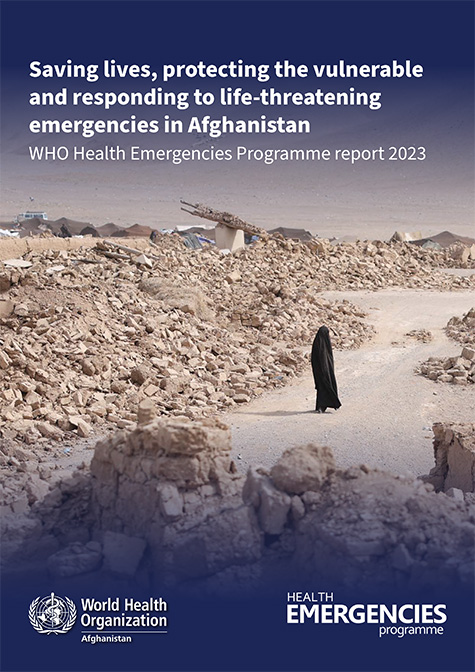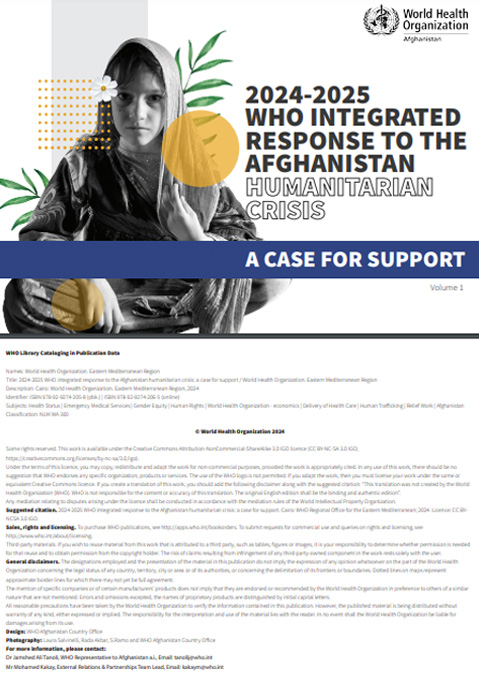Situation Update:
The burden of noncommunicable diseases (NCDs) is escalating in Afghanistan. NCDs are the cause of more than 35% of mortality (2010 Afghanistan Mortality Survey, AMS). In detail, major causes of mortality include cardiovascular disease (women 17.9%, men 14%), cancer (women 8.3%, men 7.3%), diabetes mellitus (women 2.7%, men 3.7%), and respiratory disease (women 2.3%, men 1.9%). Among women, the leading causes of death are infectious/parasitic and cardiovascular disease (18% each) followed by respiratory infections (15%).
NCDs share common preventable and modifiable risk factors such as smoking, unhealthy diets, physical inactivity and excessive consumption of alcohol. Tobacco use is a major risk factor. Based on WHO data in 2016, 8.4% of Afghans had diabetes, 13.9% were overweight and 2.4% obese. According to WHO age-standardized estimates (2013) on the prevalence of smoking among those aged 15 years or older, 35% of Afghan men are smokers and an estimated 5% of deaths were attributable to tobacco. The Afghanistan Demographic Health Survey (2015) showed that around 3% of households in Afghanistan had a family member diagnosed with cancer. Households in rural and urban areas were as likely to report family members diagnosed with cancer. Among households with at least one member diagnosed with cancer, 21% reported breast cancer, followed by liver cancer and duodenal cancer (19% each). Around 16% reported lung cancer and 5% cervical cancer.
Achievements:
§ Conducted STEP NCD risk factor survey.
§ Coordinated the joint WHO/IAEA imPACT mission on cancer control and management and finalized the report.
§ Initiated a pilot programme on NCD management at Primary Health Care level using WHO NCD-Emergency kits according to WHO Packages of Essential NCD Interventions (PEN) and the Global Heart initiative.
§ Facilitated the establishment of the Inter-ministerial Committee for Tobacco Control and multi-sectoral committee for NCDs.
§ Strengthened the implementation of tobacco control law in restaurants and hotels in the municipality of Kabul.
§ Trained two people from the Ministry of Finance to implement tobacco taxation policy.
§ Trained more than 75 police officers on tobacco control law.
§ Trained 75 school principals and teachers on preventing tobacco use among children.
§ Supported the development of IEC materials to raise awareness of NCD risk factors.
Programme Risks and Challenges:
§ Lack of commitment from the health sector to create an enabling environment to move forward on NCD prevention and control strategy.
§ Low levels of awareness of NCD risk factors in the community.
§ Inadequate funding for the implementation of the NCD strategy, and a need for multi-sectoral engagement in advancing the strategy.
Way Forward:
§ Advocate to obtain political and community commitment for NCD prevention and control.
§ Mobilize multi-sectoral engagement to implement the NCD strategy.
§ Support the implementation of the WHO Framework Convention on Tobacco Control.
§ Facilitate the integration of essential NCD interventions into community healthcare using standardized WHO tools.
§ Provide technical guidance to develop and implement a cancer control strategy.
§ Integrate the management of NCDs into healthcare settings.











